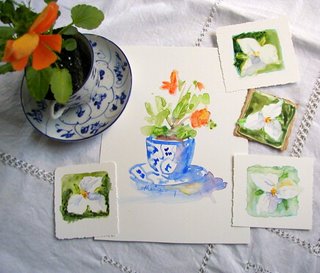
It is that time of year -
the promise of summer, but what's with all this RAIN!!!??? I am SICK of it.
I picked these lilacs for my Wednesday and Thursday classes to paint. They did a wonderful job. Some started out with wet paper, some with dry. Some of them did one of each to compare the two techniques. This was my demo, done on dry paper - it is done on Fabriano paper - something different for me. I always use Arches and I'm not sure where the Fabriano came from, and I'm not sure if I like it. It is okay to paint on, but I don't really like the look of the texture. It's just different.
These lilacs grow beside our house along the curb, and the neighbors say they see lots of drive-by-pickings. They are irresistible, and as long as they leave the blossoms alone on our side, I won't complain too much.
When I was a kid daisies and sweet peas were in such abundance at the cottage, that I still have trouble realizing that all of the sweet peas and daisies in the world aren't mine for the picking.

 Okay - this is what I mean when I say the little paintings I bring home in my sketchbook are much more meaningful to me than any photograph I could take. My friend, Karen, and I took kind of a quick trip up to Mackinac Island yesterday. My first trip up of the season. The day started out with a forecast of fog and possible thunderstorms, but by the time we got off the boat, the sun was shining and it was beautiful all day. I painted this in my Arches Carnet de Voyage, hot press paper 6 X 10. I just used my tiny Altoids paint tin and my water brush. The photograph doesn't turn me on. The painting has everything to do with the way the sunshine felt on my shoulders, the sounds of laughter coming from the Grand Hotel, the smell of the flowers, and the dappled shadows along the path. It was just a beautiful place. We had a great day!
Okay - this is what I mean when I say the little paintings I bring home in my sketchbook are much more meaningful to me than any photograph I could take. My friend, Karen, and I took kind of a quick trip up to Mackinac Island yesterday. My first trip up of the season. The day started out with a forecast of fog and possible thunderstorms, but by the time we got off the boat, the sun was shining and it was beautiful all day. I painted this in my Arches Carnet de Voyage, hot press paper 6 X 10. I just used my tiny Altoids paint tin and my water brush. The photograph doesn't turn me on. The painting has everything to do with the way the sunshine felt on my shoulders, the sounds of laughter coming from the Grand Hotel, the smell of the flowers, and the dappled shadows along the path. It was just a beautiful place. We had a great day!





